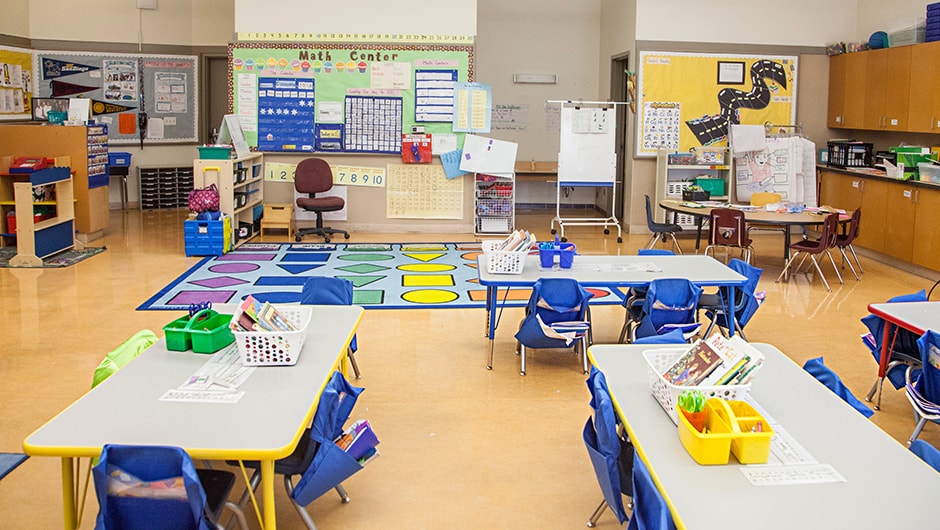Today is our first First Year Teacher Series, a special post dedicated to highlighting a specific teacher tip strategy in more detail than I do during some of my regular posts. To kick off the FYT Series I would like to start with "Setting Up Your Classroom". How spacious, attractive, a modern classroom, portable, or even a pod that you will get the keys to is out of your hands, but what you do turn it into is in your control. While you are setting up and arranging things around you will need to think about the furniture and materials.

Furniture
With furniture, it is important to focus on classroom order and functionality. Many of these issues in the classroom start with furniture. Before setting up the furniture think about these questions. How many students will I have? Do I have enough desks or tables? What furniture arrangement will be successful from day 1? Let's look at two scenarios.
A science teacher was placed in one of the smallest classrooms in the school. This size limits the teacher's options on how to design the space. The best option is to start off with desks in evenly straight rows. This allows movement between the desks and limits student interaction. Once routines, procedures, and structure are in place the teacher can move desks into tables for students to collaborate.
An elementary teacher has a large classroom so the teacher can design his vision. He groups the desks into 5 for whole class learning. Then he has a classroom library in the back corner. The elementary teacher classroom is different from the science teacher's classroom because his classroom, student's needs, and comfort level are different.
When setting up the furniture make sure to monitor all students at all times no matter if you are not teaching. For example, if you have a file cabinet or a reading nook these are places where students can be hidden and take advantage of.
Materials
The last aspect of a classroom setup is the organization of materials. Make sure regularly used items are easily accessible while less frequented used materials are stored away when the time comes. What are things that students need on a regular basis? Pencils, Notebooks, Textbooks anything else? What are some things that students don't need as much? Scissors, glue sticks, Binders? Here are a few ideas if you still need help.
A 3rd grade teacher made sure each student had a whiteboard and a clipboard in a seat pocket because those materials were going to be used regularly. Then the teacher placed the binders in the cubbies because they were going to be used rarely. The teacher also placed the notebooks into the cubbies because she has unsure if she would use them.
A high school teacher knew students would have a notebook for the first day but he had extra in case. He also had a cup of pencils on his desks if they needed one but also had a sign-out sheet to make sure the pencils were returned. In a cabinet, he stacked textbooks by class and in order so he would hand them out. By planning ahead this minimizes the time worrying about other things than students and teaching. This also increases success when school starts.

Furniture
With furniture, it is important to focus on classroom order and functionality. Many of these issues in the classroom start with furniture. Before setting up the furniture think about these questions. How many students will I have? Do I have enough desks or tables? What furniture arrangement will be successful from day 1? Let's look at two scenarios.
A science teacher was placed in one of the smallest classrooms in the school. This size limits the teacher's options on how to design the space. The best option is to start off with desks in evenly straight rows. This allows movement between the desks and limits student interaction. Once routines, procedures, and structure are in place the teacher can move desks into tables for students to collaborate.
An elementary teacher has a large classroom so the teacher can design his vision. He groups the desks into 5 for whole class learning. Then he has a classroom library in the back corner. The elementary teacher classroom is different from the science teacher's classroom because his classroom, student's needs, and comfort level are different.
When setting up the furniture make sure to monitor all students at all times no matter if you are not teaching. For example, if you have a file cabinet or a reading nook these are places where students can be hidden and take advantage of.
Materials
The last aspect of a classroom setup is the organization of materials. Make sure regularly used items are easily accessible while less frequented used materials are stored away when the time comes. What are things that students need on a regular basis? Pencils, Notebooks, Textbooks anything else? What are some things that students don't need as much? Scissors, glue sticks, Binders? Here are a few ideas if you still need help.
A 3rd grade teacher made sure each student had a whiteboard and a clipboard in a seat pocket because those materials were going to be used regularly. Then the teacher placed the binders in the cubbies because they were going to be used rarely. The teacher also placed the notebooks into the cubbies because she has unsure if she would use them.
A high school teacher knew students would have a notebook for the first day but he had extra in case. He also had a cup of pencils on his desks if they needed one but also had a sign-out sheet to make sure the pencils were returned. In a cabinet, he stacked textbooks by class and in order so he would hand them out. By planning ahead this minimizes the time worrying about other things than students and teaching. This also increases success when school starts.






















